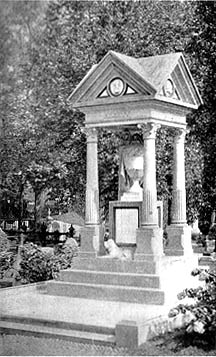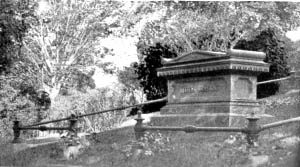The Harnden Monument
tell the story of the brave young fellow, descendant of one of the proudest families in Massachusetts, who led a regiment of the despised and oppressed race in one of the most desperate engagements of the war, and, falling in the attack on Fort Wagner, was buried in the trenches "with his niggers," as the rebel officer in command subsequently reported. Surely it is a story which justifies the further inscription on the tablet, "Greater love hath no man than this, that a man lay down his life for his friends."
But it is not only upon these individual stones that we find inscriptions which recall the great struggle for human freedom that convulsed this continent a generation ago. Opposite the chapel stands Martin Milmore's impressive figure of the Sphinx, carved out of gray granite, of colossal size, and of singular strength and beauty. It bears upon one side this inscription in terse and resonant Latin: "America Conservata, Africa Liberata, Populo Magno Assurgente, Heroum Sanguine Fuso"; and upon the other this rendering of the Latin inscription: "American Union Preserved, African Slavery Destroyed, By the Uprising of a Great People, By the Blood of Fallen Heroes." Of this figure, which, striking as it is, seems an inappropriate symbol for a Christian burial-place, Miss Charlotte Fiske Bates has written: —
"How grand she is enthroned among the dead,
The graves like trophies all about her spread.
Have these not perished as in fable old
With some unfathomed riddle in their hold?
"But what the riddle that she now doth ask,
The might of man so fatally to task?
Well may we fancy 'What are Life and Death?'
To be the question that has hushed their breath."
On Lawn Avenue rises the massive granite monument which the Boston Independent Corps of Cadets, on their 126th anniversary, October 19, 1867, dedicated to the memory of the sixteen members of the Corps who fell in defence of the Union. Panels of white marble are set into the stone, on which are inscribed the names, the coat of arms of the Cadets — a star over a shield, with the motto, Monstrat Viam — the coat of arms of Massachusetts, and that of the United States.
In the course of his address at the
To Rufus Choate.
-- page 10 --
|

